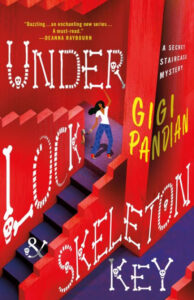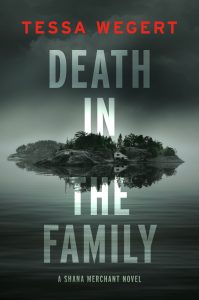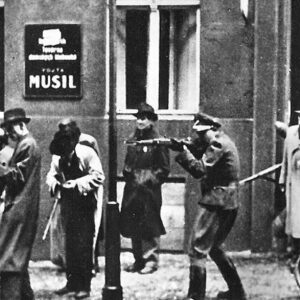The rules of fair play mysteries are clear: the reader must be just as able to solve the crime as the central sleuth. All the clues must be on the page, the how and who must be logical and rational, and the final explanation can’t involve any supernatural sleight of hand.
But even fair play mystery writers like to play around. And sometimes that takes a particular, fun form: the locked room mystery. Part of a category known as impossible crimes or sometimes miracle problems, these mysteries usually feature a dead body, clearly murdered, in a room or space that has been sealed from the inside. There’s no apparent way that a murderer could have gotten in or out, perhaps even no obvious weapon—so how was the crime committed?
The fun of locked room mysteries, of course, is that they are part of the fair play genre: the reader knows the clues are there, that the crime was committed by a real person. The seemingly impossible nature of the crime adds an extra challenge to our armchair sleuthing.
Readers and writers of mysteries have been fascinated by impossible crimes for close to two centuries. The first one is generally regarded as Edgar Allan Poe’s The Murders in the Rue Morgue, which is also often considered the first detective story because the main character’s investigation is key to unraveling its mystery. It was published over 180 years ago, in 1841. In the almost two centuries since, locked rooms and impossible crimes have continued to baffle and delight mystery lovers.
In 1892, Arthur Conan Doyle published The Speckled Band, in which Sherlock Holmes unraveled the seemingly impossible murder of a woman in a locked and sealed room. Though it is less well-known, 1892 also saw the publication of The Big Bow Mystery by Israel Zangwill. This one didn’t just feature an impossible crime; it also introduced a false solution, in which the initial explanation seems to fit the facts but in the final reveal is gradually debunked piece by piece until the true solution is unveiled. Other countries also saw writers publishing impossible crimes at the end of the 19th and beginning of the 20th centuries, such as Gaston Leroux’s The Mystery of the Yellow Room (1907) in France.
Impossible crimes continued to be popular in the early 20th century, published by writers like Edgar Wallace and Jacques Futrelle. But you might be a little disappointed if you pick up one of their novels today. Their solutions don’t seem so impossible to an audience that has a decent understanding of science, medicine, and the technology of the time.
That’s a common theme in many locked room mysteries: before the fair play genre was firmly established, many of them relied on surprise reveals, illogical contrivances (such as hidden catches or doors that would have no reason to be part of a normal room), or deliberately unreliable witnesses.
As the genre developed, though, its writers became more meticulous about their clues and solutions. The Round Room Horror by A. Demain Grange (1911), for example, was noteworthy for including a map of the location where the crime took place. This was because the locations of every element in the room, and the distances between them, were key to finding the solution to his impossible problem.
And then came the Golden Age of crime fiction. In the 1920s and 1930s, fair play mysteries exploded in popularity through the writing of authors such as Margery Allingham, Anthony Berkeley, E.C.R. Lorac, Dorothy L. Sayers, and of course, Agatha Christie.
Agatha Christie wrote many famous impossible crimes, including Murder in Mesopotamia (1936) and And Then There Were None (1939). Christianna Brand, who is less famous for her detective novels than for her children’s books, was also an accomplished writer of locked room mysteries, including her 1946 mystery, Suddenly at His Residence.
But no one can talk about the locked room genre without mentioning John Dickson Carr. Carr was American writer, but he lived in Britain for many years and is often grouped with British Golden Age mystery writers. He began publishing in 1933 and wrote dozens of crime novels, many of them locked-room mysteries like The Plague Court Murders (1934) or The Problem of the Green Capsule (1939). Carr is often considered the master of the impossible crime, and a panel of mystery reviewers and writers once selected his 1935 mystery The Hollow Man as the best locked-room mystery of all time.
But locked room mysteries weren’t all in the past. Plenty of modern mystery and suspense writers are playing with impossible crimes, and the puzzles they create are just as twisty to unravel as those of their predecessors. If you’re looking for a locked room mystery to solve, try picking up one of these newer releases:

Under Lock & Skeleton Key
by Gigi Pandian
Tempest Raj is resisting the urge to get involved with her father’s business, Secret Staircase Construction, which specializes in building sliding bookcases, nostalgic treehouses, complex locks, and hidden nooks. But then a dead body is discovered inside a wall on her father’s latest project—and the victim of this seemingly impossible crime is Tempest’s former stage double.

Death and the Conjuror
by Tom Mead
It’s London in the 1930s, and a celebrity psychologist has just been found dead inside his locked office. There are no witnesses, no clues, and no sign of the murder weapon. Stumped, Scotland Yard enlists the help of an expert in the impossible: stage magician Joseph Spector, who must help unravel not one, not two, but three impossible crimes.

Death in the Family
by Tessa Wegert
In a sleepy town in upstate New York, investigator Shana Merchant is summoned to locate a man who has vanished on a wealthy family’s private island. The disappearance seems impossible, and Shana is convinced there’s a killer in their midst. All the while, a nor’easter is bearing down on the island, further isolating Shana with the man’s increasingly suspicious family and friends.
And, if you’ll forgive a little shameless self-promotion, I’m going to add in my own most recent Lily Adler Mystery:
Death at the Manor
by Katharine Schellman
Regency widow Lily Adler visits a reportedly haunted country manor, only the discover its owner has been killed in the night, inside a locked room that no one had a key to open. The dead woman’s family is convinced that the ghost is responsible, but Lily is determined to learn the truth before another victim turns up.
***
Whether you’re brand new to the world of impossible crimes or already a fan of what John Dickson Carr called “the grandest game in the world,” you won’t run out of reading material anytime soon. After almost two centuries, there are plenty of locked room puzzles out there to explore.
You may even find yourself inspired to create an impossible crime of your own.


















